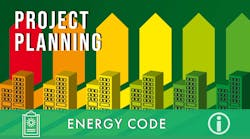ECONOMY | Custom rebates offer alternative path to energy savings
Many lighting practitioners are familiar with prescriptive commercial lighting rebates offered by utilities and energy efficiency organizations. They are typically less aware of the custom rebate opportunity. While more complex than prescriptive rebates, custom rebates can be more financially rewarding, can apply to new as well as existing construction, and are friendly with advanced lighting controls and more holistic projects.
For decades, utilities have offered commercial lighting and other energy-saving equipment rebates as a way to satisfy growing demand for power using a least-cost resource strategy. This means if it is cheaper to incentivize customers to use less energy than to build new generating capacity, they favor that investment. Commercial lighting rebates vary by territory but are widely available in the U.S.
The most popular type of commercial lighting rebate is the prescriptive rebate, where the utility awards a cash amount per qualifying installed product — whether that be an LED luminaire, occupancy sensor, or some other lighting equipment type. This type of rebate is fairly straightforward and simple, particularly if the rebate is a midstream (“instant”) rebate, where the rebate is realized at the point of sale.
With a custom rebate, the owner’s project team proposes a project to the utility and, if approved, receives an incentive based on energy savings. This option poses certain benefits for the rebate program, owner, and lighting practitioner.
From the rebate program operator’s perspective, the approach is desirable because energy savings are generally more accurate — especially when measurement and verification are required by agreement. It also provides a way for the rebate program to incentivize new technologies, projects where energy savings are harder to predict, and holistic projects involving multiple building systems that interact for significant energy savings potential.
For the property owner, the incentive may be more financially rewarding while supporting development of bolder, more comprehensive solutions that may qualify for the Commercial Buildings Tax Deduction and support wider owner goals aimed at minimizing carbon footprint.
For the lighting practitioner, custom rebates recognize innovation and projects where the lighting is redesigned instead of replaced on a one-for-one basis.
To better understand this rebate type, I engaged two major rebate experts: the DesignLights Consortium (DLC) and rebate fulfillment provider BriteSwitch. Here’s what I learned.
Categorizing custom rebates
While custom rebates are simple enough to define, they can vary widely based on local market conditions. The rebate offered by a given program will reflect the local region’s characteristics and the program goals.
Type of project. While prescriptive rebates applicable to new construction exist, they primarily target existing buildings. In contrast, custom rebates may apply to either new or existing construction, depending on the utility and program. Given their role as an alternative to prescriptive rebates when those rebates do not fit, custom rebates tend to be favored for larger, more difficult projects.
In the case of a major lighting upgrade in an existing building, the rebate program is likely to offer a spreadsheet or form requesting a description of the existing lighting system, which may require an audit. Similar data is then presented for the proposed lighting and control system, along with the project cost. This information is used to calculate energy savings.
In the case of new construction, the baseline of energy efficiency is typically aligned with local commercial building energy-code compliance. The project team presents a plan for a proposed lighting system — which may involve modeling and project drawings — that demonstrates significant savings compared to code minimums. This approach may also suit existing buildings where the lighting system will undergo a major redesign, with savings based on either the existing lighting system or the energy code, depending on the program requirements.
Incentive. While some prescriptive rebate programs have begun to experiment with basing incentives on wattage saved, generally they award a cash amount per qualifying installed product. Custom incentives focus more on the result.
The rebate may be based on energy or power demand reductions on a $/kWh or $/kW basis or a mix of the two. Some design-focused programs may award the rebate based on $/kWh controlled, $/sq.ft., reduction in lighting power density (LPD), or a percentage of the project cost.
According to BriteSwitch, the most common method is $/kWh saved, with a North American average of $0.5/kWh saved.
Technologies. Custom rebates offer a proving ground for new technologies as well as equipment whose energy savings are variable and difficult to predict. As these technologies mature, they tend to start showing up in prescriptive programs, with notable examples being LED lighting, networked lighting controls, and more recently horticultural LED lighting.
Some custom rebate programs specifically cover lighting, while others focus on comprehensive upgrades that may include lighting as part of the mix. If the program’s territory has significant LED lighting saturation, operators are more likely to favor incentives packaging multiple technologies.
Advanced lighting controls. Since energy savings can vary based on application with accelerated savings achieved through interactions with other building systems, advanced lighting controls are highly suited to custom rebates.
Prescriptive rebates for basic options such as occupancy sensors and daylight dimming systems have been widely available for years. In recent years, an increasing number of prescriptive programs have begun rebating networked lighting controls using various approaches, the most common of which is a rebate adder per LED luminaire controlled by an NLC.
Otherwise, the custom option may be suitable for advanced lighting control systems like networked lighting controls, particularly if the control system integrates with another building system such as HVAC for accelerated savings. The resulting incentive may be higher than applying for individual prescriptive rebates. Another feature making networked control technology highly suited to custom programs is its measuring and monitoring capability.
Pursuing a custom rebate – A simple to-do list
- Engage with the rebate program as early as possible.
- Apply and gain pre-approval for rebates, which is required so that the program administrators can ensure eligibility requirements are satisfied.
- Build time into the project to allow the rebate program to review and respond.
- Diligently complete and provide all required paperwork and documentation.
- Communicate any project changes to the rebate program as soon as possible, as these changes may affect the incentive and project eligibility.
- Understand that the rebate program may require energy savings measurement and verification, which can be accomplished by metering or via an appropriate networked lighting control solution.
Custom rebate trends
Ongoing market developments may result in several trends in custom incentives.
The role of custom rebates may be narrowing, particularly for new construction as energy codes become increasingly strict and it therefore becomes more challenging to substantially exceed code minimums. Rebate programs may emphasize more holistic projects where lighting is part of an overall building upgrade involving multiple systems.
In terms of lighting, networked lighting controls overall straddle both prescriptive and custom rebate program types, but may become increasingly favored in prescriptive programs as a technology.
While the role of custom rebates narrows, rebate programs maintain an overall interest in achieving more accurate energy savings. In the future, rebate programs may increasingly experiment with valuing prescriptive rebates on an energy or power saved basis, and they may step up efforts toward measuring and verification.
As carbon mitigation continues to grow in importance in the future, custom rebates may see a resurgence as building owners invest in deeper, more holistic retrofits to minimize carbon footprint.
The custom option
Overall, custom rebates offer a potentially lucrative incentive path for energy efficiency projects that do not fit the standard mold. To learn more, talk to your local utility and determine what programming is available in your region.
Follow our LinkedIn page for our latest news updates, contributed articles, and commentary, and our Facebook page for events announcements and more. You can also find us on the X platform.

Craig DiLouie
Craig DiLouie, LC, CLCP, is education director for the Lighting Controls Association, a council of the National Electrical Manufacturers Association dedicated to educating the public about lighting control technology and application. Learn more at lightingcontrolsassociation.org.











